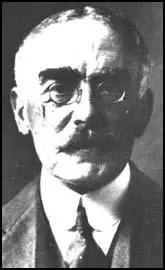Henry Perry Robinson

Henry Perry Robinson was born in 1859. After an education at Westminster School and Christ Church, Oxford, he moved to the United States and began a career in journalism. Between 1883 and 1900 he owned and edited the journal, The Railway Age.
Robinson returned to England in 1900 and joined The Times as its special correspondent. He covered all the major news stories of the period. He also wrote several books, including two novels and several non-fiction works on natural history.
On the outbreak of the First World War, Robinson was sent to Belgium where he was nearly captured by advancing German troops. By the end of August, Robinson reached Antwerp but was forced to flee to Holland when the city was taken by German forces in October.
In January, 1915, the British Government decided to select five official journalists to report the war. Robinson reported the war for The Times and the Daily News and was joined by Philip Gibbs (Daily Chronicle and the Daily Telegraph), Percival Phillips (Daily Express and the Morning Post), William Beach Thomas (Daily Mail and the Daily Mirror) and Herbert Russell (Reuters News Agency). Before their reports could be sent back to England, they had to be submitted to C. E. Montague, the former leader writer of the Manchester Guardian.
In the summer of 1915 Robinson went to Serbia and was later based at the G.H.Q on the Western Front. Although he rarely went to the front-line, Robinson spent the next couple of years sending reports based on information provided by the British Army. During the war Robinson published his book on the Battle of the Somme,The Turning Point (1917).
After the Armistice Robinson retired from journalism to write books on natural history. In 1920, Robinson, like other official journalists during the war, was granted a knighthood by George V. Henry Perry Robinson died in 1930.
Primary Sources
(1) Henry Perry Robinson, The Turning Point: The Battle of the Somme (1917)
Never since the war had entered on its stationary phase in the existing positions had there been anything approaching in scope and intensity the shelling and miscellaneous fighting which raged along a hundred miles front. It was only the overture; but it was stupendous and terrifying, even though what one saw or heard was only a small section of the dreadful whole.
(2) Henry Perry Robinson reported the offensive at Messines Ridge in the The Times on 8th June, 1917.
How many mines went up at once I do not exactly know, but it was nearly a score. Many of these mines were made over a year ago, and since then had lain under German feet undiscovered. In all, I believe over 600 tons of high explosives were fired simultaneously. Can you imagine what over 600 tons of explosives in 20 or so blasts along an arc of 10 miles looks like? I cannot describe it for you. Personally, I can only vouch for having seen nine of the great leaping streams of orange flame which shot upwards from that part of the front immediately before me, each one of the nine a huge volcano in itself, with as many volcanoes going off at the same moment beyond them, hidden by their flames and out of sight, and each vast sheet of flame as it leaped roaring upwards threw up dense masses of dust and smoke, which stood like great pillars towering into the sky, all illuminated by the fires below.
